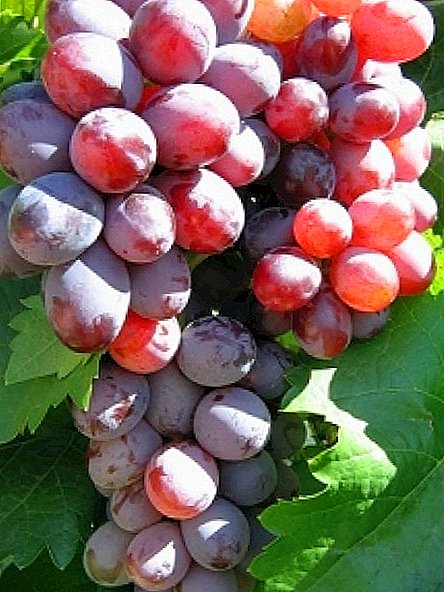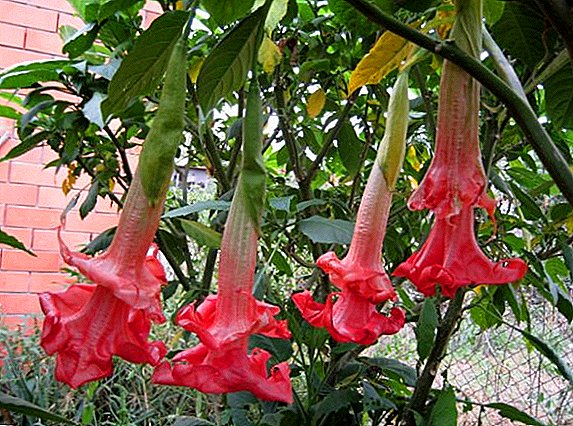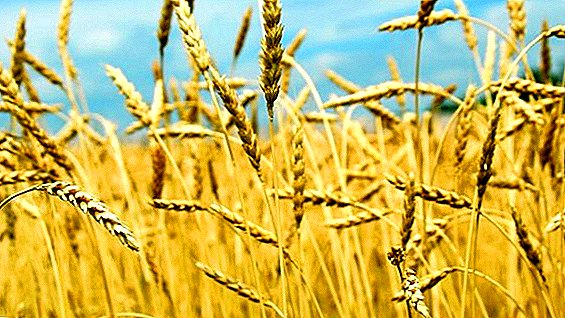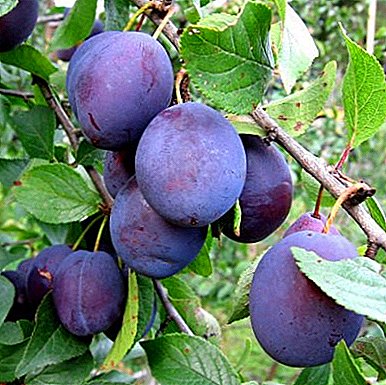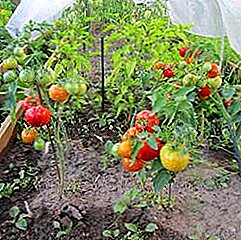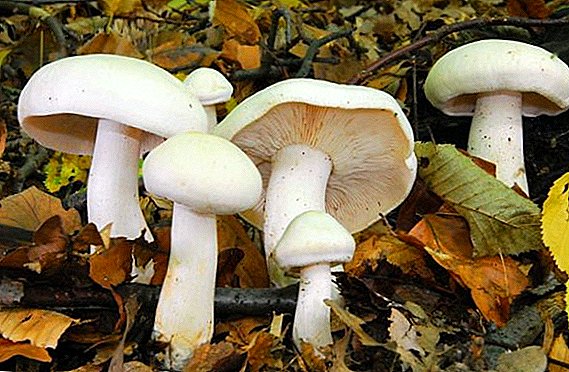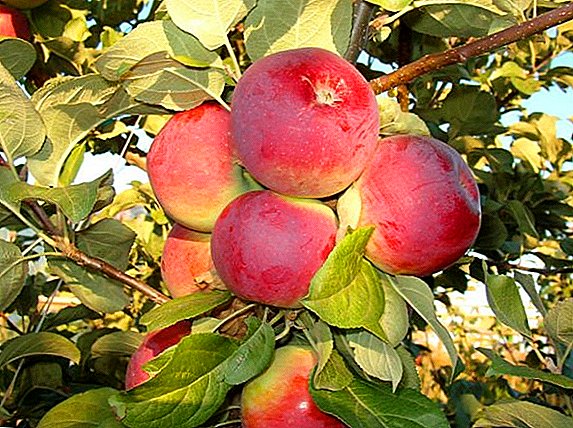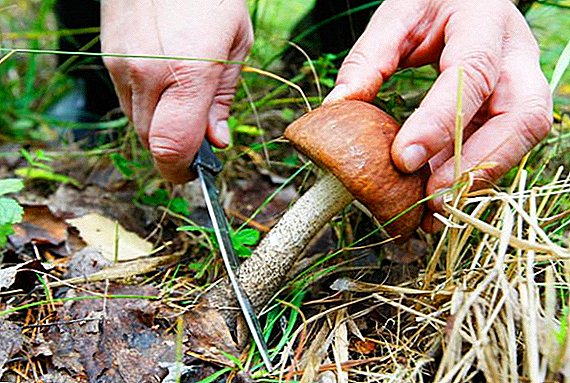 In each region, there are some edible and poisonous mushrooms, which should be known to both experienced mushroom pickers and beginners.
In each region, there are some edible and poisonous mushrooms, which should be known to both experienced mushroom pickers and beginners.
Consider the main types of edible and inedible mushrooms of Bashkortostan, we give a complete description, as well as tell about the use in cooking.
Edible Mushrooms
Consider the characteristics and description of all types of edible mushrooms that can be found in Bashkiria.
White mushroom
The mushroom belongs to the Borovik genus, the Boletov family. 
Alternative names: boletus, white, painter, yellow, kovyl, cow, bear.
Important! In those regions where the white fungus does not occur, the name is the boletus and the oyster mushroom steppe.
Appearance
Hat in diameter it can reach 60 cm, but the average size is 15–20 cm. In young mushrooms it is 7 cm. The shape is convex, the surface is smooth, and it may be slightly wrinkled. In the absence of rain, the cap may crack. Color varies from brown to pure white. The top layer of the cap is not separated from the pulp.
Pulp very meaty. With age begins to turn yellow, so the color varies from white to dark yellow. After contact with air, only rarely changes color (becomes pinkish or bluish). The smell is very weak, the taste is pleasant. 
Leg reaches a length of 25 cm, cylindrical or club-shaped with a narrowing to the cap. Painted in different shades of brown, but may be white. The color is always lighter than the cap.
Tubular layer (carries spores) light or white, easily separated from the cap. Older mushrooms may have a greenish or brownish tint.
The remains of the blankets from the white fungus are absent.
Learn about varieties of white mushrooms, the beneficial properties of white mushrooms, what a false white mushroom looks like.Distribution area
White mushroom grows on all continents, except the poles and Australia. It is characterized by the formation of mycorrhiza (symbiosis) with deciduous or coniferous trees, therefore it practically does not occur in the steppe zone. He likes forests in which the substrate is covered with moss or lichen.
The fruit body does not form if there are large daytime or night temperature drops. The fungus also does not like increased humidity, so it rarely grows near water bodies. 
Important! Borovik not found in young forests.
Collection time
Since fruit bodies do not form constantly, but with peculiar "waves", they come to the first collection in the middle of June. The second time is at the end of July. The third time is mid-end of September, when leaves fall from the trees.
At the same time, in mountain forests, mushrooms are harvested only in August, when the mycelium produces the most fruit bodies.
Use in cooking
Since this mushroom has a very strong pleasant smell after drying, it is often harvested for the winter. A powder is made from a dry product, which is used both for dressing dishes and in production for the production of various flavoring seasonings. 
Boletus does not require pre-heat treatment, so in Europe it is consumed fresh, adding to various salads. In the CIS countries, it is customary to cook soup with porcini mushrooms, fry with potatoes, and also to make various pastries.
Familiarize yourself with various methods of harvesting white mushrooms for the winter, and learn how to freeze white mushrooms.
White mushroom can be pickled or pickled with its addition. This is a versatile mushroom that fits almost any dish, and also significantly increases the nutritional value of food.
Wolf
Belongs to the genus Mlechnik, the Syréegek family. There are white and pink waves. The first option differs from the second in smaller sizes and a pure white color. Both varieties are edible.
Alternative names: Volzhanka, wave, rubella. 
Appearance
The diameter of the cap is from 4 to 12 cm, however, large sizes are extremely rare. It has a characteristic notch in the center, which smoothly passes to the straight edges. The young mushrooms convex, the old - flat.
The surface is covered with small villi, as well as darker circles. It has a light or dark pink color. If you touch the cap, it begins to darken.
Pulp dense, white. In the place of breakage, the milky juice of white color stands out, which has a sharp taste. The smell is pleasant or neutral.
Length legs from 3 to 6 cm, thin, strong, solid. It has a pale pink or white color.
Records white, frequent, narrow. 
Distribution area
It is found in the northern part of the temperate zone. Volnushka is common in birch and mixed forests. At the same time, mycorrhiza forms only with old trees, therefore it does not occur in young plantings.
Collection time
Fruit bodies are formed from the end of June to October, but there are two main waves during which you can collect the maximum number of mushrooms. The first wave is the last weeks of July. The second is the end of August and the first two weeks of September.
Use in cooking
Volnushka is a semi-edible mushroom, therefore it requires prior soaking in salt water and heat treatment. Collected mushrooms are blanched, and then proceed to cooking. Blanching takes about 15-20 minutes.
Volnushku most often pickled or salted, but you can use this mushroom and for cooking soups. It can be fried or added to sauces. The mushroom does not fall apart and does not crumble, which allows you to decorate dishes with it. 
The volnushka is not dried, because during this process it does not get rid of substances that can cause mild poisoning or indigestion.
Real bum
Belongs to the genus Mlechnik, the Syrmejka family. A real mushroom is very similar to a white wave, so only an experienced mushroom picker can distinguish them.
Read the description of the types of mushrooms, find out how the aspen, black blackberry looks and where it grows, what useful mushrooms are, how to prepare milk mushrooms for the winter.
Alternative names: white gruzd, raw gruzd, pravsky gruzd.
Appearance
The diameter of the cap is from 5 to 20 cm. Dense, flat-convex, curved edges. In the center of the cap there is a characteristic recess. Covered with mucus, so often it can detect particles of soil or foliage. The color is white or yellowish. 
Important! Old fungi on the cap may appear dark spots.
Leg about 5 cm long, thickened, painted white or light yellow. On the surface, you can find subtle spots or small recesses. Inside the leg is hollow.
Pulp very dense, white, has a strong fruity odor. When breaking, milky juice of white color is released, which has an unpleasant sharp taste. After contact with air, the juice begins to turn yellow.
Records have a yellowish tint, wide. Disputes are yellow.
Distribution area
Distributed in the northern zones of the temperate climate zone. It enters into symbiosis with a birch tree, therefore it is found only in those territories where this tree grows. It prefers old trees, it does not grow near young ones. 
The mushroom loves sandy and sandy soils, as well as high humidity. Look for it should be in shaded places, under the leaf or conifer litter.
It is quite difficult to meet a grudge, but if you saw one mushroom, it means that you can find "brothers" nearby, since this species grows only in groups.
Collection time
The fruit body is formed at a temperature of + 8-10 ° C, therefore, in each region fruits at different times, starting in July and ending in September, when the average daily temperature drops to an acceptable range.
Use in cooking
This type of mushroom is also considered conditionally edible in our country, but in European countries it is classified as poorly edible or inedible. This means that before cooking it must be soaked in salted solution, then boil it with subsequent replacement of water. 
Several centuries ago, milkfish was considered the only mushroom suitable for salting, as it has dense flesh. That is why it is often salted or pickled, using oak barrels (it is about large volumes).
After pretreatment, milk mushrooms can be stewed, fried, added to soups or salads. The product contains a lot of protein (up to 32% in terms of dry matter), so they can replace meat or fish.
As is the case with other conditionally edible mushrooms, the real gruel is not subject to drying.
Dubovik olive brown
Edible mushroom, which belongs to the Boletov family, Borovik genus.
Alternative names: dubovik, subad, bruise, hurts dirty brown. In some regions, this species may be identified with the cep. 
Appearance
Hat in diameter from 5 to 20 cm. In young mushrooms it is hemispherical, in old ones it is almost flat. The skin is painted in olive-brown color, which is why the species got its name. The color may change during the formation of the fruit body.
The surface of the cap is velvety. After contact, dark spots appear. At increased humidity, it becomes covered with mucus.
Pulp colored yellow, dense. Contact with oxygen changes color several times. First becomes blue, and then brown. It has no smell, the taste is not sharp.
Leg has a length of 6-15 cm, thickened, dense. The shape resembles a mace, tapers towards the head. Painted in dark orange or dark yellow, always lighter than the cap. There is a mesh pattern. 
Tubular layer in young mushrooms it is colored yellow, in old ones it is painted in marsh green. Between the pulp and the tubular layer there is an additional red layer, which is visible only on the cut.
Did you know? Antibiotic boletole is extracted from this fungus, which is used in traditional medicine.
Distribution area
Distributed throughout the temperate zone. In the northern regions is rare, because it loves a warm climate. It enters into symbiosis with oak and beech, more rarely with birch, therefore it is found in both deciduous and mixed forests. In the steppe zone does not grow.
Separately it is necessary to highlight the requirements for the soil. Dubovik loves alkaline soil, therefore it does not grow on the acid substrate, even if the conditions are favorable. Occurs near marshes. 
Collection time
Fruit bodies are formed from May to September, but the most mushrooms can be collected in August. Fruit bodies are formed both in groups and individually, choosing well-warmed illuminated places.
Use in cooking
Conditionally edible fungus, which must first be boiled with water replacement. After the initial processing, you can fry, boil, simmer, salt, pickle, and dry. It is an excellent filling for pies, used as a meat substitute in many dishes, as it has good nutritional value.
Important! You can not use dubovik with alcoholic beverages.
Umbrella colorful
Belongs to the family Champignon, genus Macrolepiota. This species is a "fellow" champignon, although it looks like a poisonous mushroom. 
Alternative names: mushroom umbrella, umbrella, drumstick.
Appearance
The cap has a diameter of 25-35 cm. In young mushrooms it resembles a large egg, in old ones it is a conical umbrella. The surface is painted gray, there are dark scales that are unevenly distributed over the surface. In the center of the cap there is a dark bump. The skin is fibrous.
Pulp rather fleshy, friable, painted white. In old mushrooms, the pulp is dense, has a darker color. In contact with oxygen, the color does not change. It has a weak mushroom smell and the same taste, gives a nut.
Leg in length from 10 to 30 cm, thin, hollow, has a thickening at the base. Color from pure white to dark gray (gradient). Covered with small scales. Near you can see the radial rings.
White plates, free, easily separated from the pulp. In old mushrooms painted beige or cream color. 
There are remains of blankets that move freely along the leg. Painted white, have a forked edge.
Distribution area
Since the motley umbrella is a representative of saprotrophs (the mycelium feeds on dead or dying wood), it can be found in old forest plantations where regular sanitary cuttings are not carried out.
The fungus prefers sandy soils, and also selects well-lit places. It grows not only in forests, but also in open areas, as well as in flower beds and gardens.
It grows in the temperate zone. It is found in Europe and Asia, as well as in South and North America, as well as in Australia. 
Collection time
Collected from June to November. On the "hunt" go after a little rain. Mushrooms grow both singly and in small groups. Often, fruit bodies form interesting patterns, as well as rows.
Use in cooking
The mushroom is completely edible, therefore does not require pre-treatment. However, after collection, it is recommended to gently rinse the products to remove the sand. Young fruit bodies can be grilled, and adults can be pickled, sour or added to soups.
Stiff mushroom legs are dried, and then make a powder. It is used as a seasoning for the first and second courses, has a wonderful aroma.
Umbrellas are cooked very quickly, so you can make scrambled eggs or scrambled eggs on their basis. After long frying, the fruit bodies become "rubber", which must be taken into account. 
Important! Before cooking, be sure to remove the scales.
Goat
Belongs to the genus Shrove, of the same name of the butter-grease family. Tubular fungus is often called precisely the butter dish, and not the goat.
Alternative names: louter, mokhovik, mshornik.
Important! Do not confuse the alternative name "Mokhovik" with a separate genus of mushrooms.
Appearance
Hat in diameter from 3 to 12 cm, flat-convex, pillow. Painted in light brown glossy color with a reddish tinge. Peel at high humidity is covered with mucus, difficult to separate from the pulp. 
Pulp dense, elastic, dark yellow or light brown color. The smell is very weak, almost absent. The taste is slightly sour.
Leg in length from 4 to 10 cm, the average thickness, in shape resembles a cylinder with a slight curvature at the base. Painted light brown. Leg tight.
Tubular layer adherent, covered with pores, the structure resembles a sponge. Painted in yellow with a brown or gray tint.
Distribution area
It is found in Europe and Asia throughout the temperate zone. Enters symbiosis with a pine tree, less often - with other coniferous trees. It grows on acidic nutrient wet soils. You can find a large number of mushrooms near the marshes and marshy fields. 
Collection time
Kozlyak collected after the rain. Mushrooms grow both individually and in large groups. Fruit bodies form from June to October; however, in the absence of precipitation, fruiting is shifted closer to autumn.
Use in cooking
Although the mushroom is edible, it should be boiled for about 15 minutes before use. After that you can eat without further heat treatment.
Goat can be dried, cooked, fried, added to pickles. Since this species is most often affected by various parasites, only young fruiting bodies are used for marinating, in which the worms have not yet been “settled”. 
Chanterelle
Belongs to the genus of the same name from the Lysichkov family.
Alternative names: cockerel, chanterelle real.
Learn about the medicinal properties of chanterelles, how to distinguish a false chanterelle, how to freeze chanterelles for the winter.
Appearance
The mushroom is a cappulmonary, so the cap and pedicle are one.
Hat in diameter from 2 to 12 cm. This variation is due to the fact that the chanterelle has wavy edges that are raised up. The shape of the cap is concave-prostrate, irregular. The peel is colored orange.
On old mushrooms dark spots of light brown color can settle down. The surface is smooth, matte. Separate the skin from the pulp is almost impossible. 
Pulp dense, fleshy, hard in old mushrooms. The cut color is white, but the exterior is painted in a light orange color. It has a faint mushroom smell. It tastes sour. When pressed slightly darkens.
Leg has a length of 4 to 7 cm, thick, dense, has the same color as the cap, or slightly lighter.
Tubular layer consists of large fibrous folds, which are painted in light orange color, strongly descend to the stem.
Important! This chanterelle is not affected by parasites, since a symbiotic lives in the tubular layer, which destroys the eggs of worms and insects.Distribution area
Enters symbiosis with deciduous and coniferous trees (spruce, pine, beech, oak), therefore, it is found in both deciduous and coniferous, or mixed forests. Chanterelles are common throughout the temperate zone. Prefer places with high humidity. 
Collection time
Chanterelles hunt for chanterelles in June, if the weather is wet and warm. The following "waves" appear from August to October, but if it has not been raining for a long time, then finding young fruit bodies will be problematic.
Mushrooms hiding in fallen leaves, grass and mosses, so they are easy to miss. Grow groups, single mushrooms - a rarity.
Use in cooking
Chanterelles can be consumed in any form, but it is worth knowing that this mushroom absorbs radionuclides, so if your area is not okay with the radiation background, then it is better not to cut off the cockerels.
Chanterelles can be cooked, stewed, boiled, pickled, dried, salted, and grilled. This is a versatile mushroom that fits any dish. 
The composition of the fungus includes a lot of protein, so it can be used as a substitute for meat. However, it is worth knowing that the caloric content of 100 g of the product is only 19 kcal, so large volumes of the product will be required for saturation. Due to the low calorie content, chanterelles are included in salads for those who follow a diet.
Wet spotted
A species of fungus that belongs to the genus of the same name, the Mokrukhovye family.
No other names are available.
Appearance
The diameter of the cap is 4-5 cm. Convex or flat with curved edges. The skin is pale pink, covered with mucus. Dark spots are scattered all over the surface. It gets dark when touched. 
Pulp may be yellow or white. After contact with oxygen begins to turn red.
Length legs about 8 cm. Thin, sticky, has a cylindrical shape. The leg is spotty, painted white. Drops of amber color can form.
Under the cap are rare white recordswhich may eventually turn brown.
Distribution area
Mokruha is distributed throughout the temperate zone of Eurasia and North America. It forms mycorrhiza with conifers, therefore it does not occur in deciduous forests. Mushroom prefers high humidity. It grows between mosses and tall grasses, so it is difficult to detect. 
Collection time Fruit bodies appear from July to October, with one mycelium producing a small amount of fungi. Wethook is a rare species, so even in the presence of wet weather, it is unlikely that it will be possible to collect large volumes.
Did you know? The cap of mushrooms during growth can penetrate even iron. This is achieved due to the fact that the turgor (internal) pressure reaches seven atmospheres. The same pressure is observed in dump truck tires.Use in cooking
Mokruhu is classified as a fully edible mushroom, so no pretreatment according to logic is required. However, due to the fact that the cap is covered with mucus, pre-soaking and removal of the skin is necessary to get a pleasant, tasty product.
Mushrooms do not eat raw. If mokruhu added to the salad, then it is pre-boil for at least half an hour. Most often, this type of mushroom is salted or marinated. Also used as decoration for cold dishes. Based on them, you can make a delicious broth or sauce. 
Mokruha is not suitable for drying.
Mokhovik green
Belongs to the Mokhovik family, the Boletov family.
Alternative names: sitovik, fur coat. Appearance
The diameter of the cap is 3-10 cm, but you can find giant mushrooms with a cap up to 16 cm in diameter. Hat brown, velvety, dome-shaped with slightly upturned edges. Pulp white color. Contact with oxygen may turn slightly blue.
Leg has the shape of a cylinder, length from 4 to 10 cm. Thin, smooth, the surface is covered with brown mesh.
Tubular layer adherent, yellow with a greenish tint. Strong pressure can turn blue. 
Distribution area
This mushroom is not tied to the forest or steppe zone. It is found both in open areas and in forests. Forms mycorrhiza with any coniferous or deciduous trees. Mokhovik distributed on almost all continents, including Australia. It grows both in the subtropics and in the subarctic belt.
Collection time
It is possible to pick mushrooms from May to October, however it should be noted that fruit bodies do not form in cold or dry weather.
Mokhovikov grow both singly and in small groups. A large "harvest" can be harvested only on well-lit nutrient soils. 
Use in cooking
Mokhovik does not require pre-treatment, so you can eat it even raw, but you must first remove the skin from the cap.
This species is rarely dried, as it begins to blacken. It is distinguished by good preservation, therefore it is salted and pickled, as a result of which billets are obtained that are stored for more than one year.
Fresh fruit bodies can be boiled, fried, stewed, and also added to sauces or salads.
Important! Old boletus can cause severe poisoning, so they can not be collected. This is due to the breakdown of the protein inside the fruit body.

Autumn honeycomb
Belongs to the genus of the same name, from the Fizalakriev family.
Alternative name: honeydew present.
Find out what edible mushrooms look like, how to distinguish a foam pellet from ordinary mushrooms.
Appearance
Diameter hats 3-10 cm, with rare exceptions - 12-15 cm. Young mushrooms have a convex cap, old ones - flat. The skin is light brown or greenish-olive. Young fruit bodies have small scales that disappear over time.
Pulp white color. Young mushrooms have a dense and rather fleshy, old ones have a thin, tough one. The smell is pleasant, mushroom. 
Length legs from 8 to 10 cm, thin, painted in a light brown color. The leg is always lighter than the cap. Small scales that are easily washed away by precipitation are noticeable.
LPs adherent to the peduncle, rare, in young flesh-colored fungi, in old ones brown with a pink tinge.
There are remains of bedspreads, which are located directly under the bonnet. The cover is white with a yellow edge, filmy.
Important! The color of the cap may vary depending on the tree on which the honeydew parasitizes.Distribution area
Before us is a type of parasitic fungi whose mycelium is formed in the wood of a tree. In rare cases, it can parasitize on herbaceous plants, including cultivated ones. Mushrooms can grow on rotten and dry trees, thereby partially being saprophytes. 
They grow only in the forest and forest-steppe zone of the Northern Hemisphere. At the same time, they are distributed from subtropics to polar regions. They like high humidity, as well as the absence of sanitary felling. In parks and well-groomed squares are extremely rare.
Collection time
Fruits in late August and until the first frost. It grows in waves, up to three per season. Fruit bodies are formed for 20 days, followed by a short break.
If the weather is wet and the air temperature is within + 10-15 ° C, then about 150-200 kg of mushrooms can be collected from one hectare. The maximum "harvest" is obtained in the first weeks of September.
Did you know? Mycelium glows in the dark near autumn meadow. At the same time, during the change of the angle, a false feeling is created that the mycelium is constantly moving. Such a luminescence is not observed in a poisonous false mushroom.Use in cooking
This is a universal type of mushroom that is suitable for frying, boiling, drying, salting, pickling. 
In Western Europe, mushrooms are referred to as conditionally edible mushrooms, as undercooked fruit bodies can cause mild poisoning. In the domestic literature mushrooms have always been described as edible mushrooms with excellent taste.
Common boletus
Type of spongy fungi of the genus Leccinium, Boletov family.
Alternative names: Berezovik, Chernogolovik, obabok.
Appearance
Diameter hats from 5 to 14 cm. In young mushrooms it can resemble a ball in shape, in more mature ones it can resemble a dome. The skin can be of a different color: from pale gray to almost black with a reddish tinge. 
Pulp white color. Upon contact with air, the color does not change or becomes pale pink. There is a pleasant mushroom smell.
Length legs from 8 to 15 cm, thick, dense, cylindrical in shape with a slight expansion downwards. Painted in gray, there are small dark scales.
Tubular layer in young mushrooms is white, then turns gray. The layer is elastic, easily separated from the cap.
Distribution area
According to the name, this type of mushroom comes into symbiosis with birch trees, therefore it is found only in those forests where this tree grows. It can form mycorrhiza even with dwarf or decorative birch. 
Collection time
Harvest season starts in May, when the first mushrooms appear. Fruit bodies die off during the first frosts, so at the end of September the collection is stopped. Search for large groups of boletus should be in well-lit forest glades that are distant from the edge of the landing.
Use in cooking
Boletus mushrooms do not require pre-treatment, however, if the harvest was carried out on sandy soils, then the collected fruit bodies should be soaked in water for several hours.
Boletus is a versatile mushroom, so it can be fried, stewed, boiled, pickled, and salted. If you have a good harvest, then you can dry it, but in this form the mushrooms do not differ in full taste, but have a good aroma. 
Mushrooms deteriorate quickly, so immediately after harvesting they need to be cleaned and boiled. Cooked boletus can lie in the refrigerator for no more than 48 hours.
Important! Raw mushrooms can not be frozen, as the protein breaks down even at low temperatures. This leads to poisoning.
Aspen red
Belongs to the genus Obabok, the Boletov family.
Alternative names: Aspen, red mushroom, krasyuk, redhead.
Appearance
Diameter hats from 4 to 15 cm. Hemispherical in young mushrooms, cushion-shaped, convex in mature ones. The peel is colored in various shades of red and orange. The top layer is not separated from the cap. 
Pulp very fleshy, dense and resilient. In mature fruit bodies, it is softer. On the white cut, however, it quickly turns blue on contact with oxygen. After a few hours it turns black.
Length legs from 5 to 15 cm, very thick, solid. At the bottom there is an extension. The stem is gray with noticeable brownish scales.
Familiarize yourself with typical representatives of aspen mushrooms, how to distinguish edible redhead, how to identify a false aspen.
Tubular layer white, easily separated from the cap. Older mushrooms may have an olive or yellow hue. The surface is porous, darkens on touch.
Distribution area
This species of aspen mushrooms is widely used for the reason that, unlike the "brothers", the red variety forms mycorrhiza not only with aspen, but also with other deciduous trees (poplar, beech, hornbeam, birch). Prefers young trees. In coniferous forests is not found. 
Collection time
Fruit bodies are formed from June to October.
Mushrooms appear in three "waves":
- the first is in the last week of June;
- the second - 2-3 week of July;
- the third - from 3 weeks of August until the end of September.
In October, the fungus does not fruit well; therefore, it is possible to meet only single fruit bodies, and only in rare cases small groups.
Use in cooking
Aspen is a valuable edible mushroom of the second category. It can be salted, pickled, dried, salted, fried or boiled. In the CIS countries, all parts of the fungus are used, and in Western Europe, only caps are used, since the leg is a little stiff. 
Aspen is a great substitute for meat. On its basis, delicious nutritious soups are cooked, fried along with potatoes or seasonal vegetables. At the same time, nutrients are best preserved during drying, so the orange-cap boletus is considered to be the best mushroom for harvesting for the winter.
Real ginger
It belongs to the genus Mlechnik, the Syrmejka family.
Alternative names: autumn flaxberry, pine flaxberry, deli ginger mushroom.
Appearance
Diameter hats from 4 to 18 cm. In young mushrooms, the shape is convex, in mature ones - flat, funnel-shaped. In the center of the cap is a characteristic recess. The peel is orange, there are dark concentric circles. The surface is smooth, shiny, at high humidity becomes sticky. 
Pulp orange, dense, on contact with oxygen begins to turn green.
Leg cylindrical, thick, straight, hollow inside, has the same color as the cap (in some cases, slightly lighter). Length from 3 to 7 cm. Small dents are noticeable on the surface.
Records thin, orange, change color to light green when pressed.
On the cut of the pulp there is a thick orange milky juice, which has a light fruity smell. The taste is pleasant.
Distribution area
Distributed in coniferous and mixed forests of the temperate zone of Eurasia. It grows mainly in groups under a pine or spruce. It is difficult to detect, as the mushrooms are sprinkled with fallen needles or covered with moss. 
Collection time
Mushrooms appear from July to October, but the mass fructification occurs at the end of July and the end of August. Many fruit bodies also ripen in the first week of September.
Use in cooking
This type belongs to the first category. Mushrooms are often marinated or salted without prior treatment. They are also added to soups, sauces, salads. Mushrooms are not suitable for drying. 
Morel ordinary
Mushroom of the genus of the same name, family Morel.
Alternative name: morel edible.
Appearance
Morel has a non-standard a hat ovoid-conical shape, which has a diameter of 3-6 cm and a height of up to 7 cm. The color can vary from dark yellow to brown. The surface is wrinkled, covered with deep and shallow grooves, which have an irregular shape. The hat resembles a large sponge.
White or yellowish thin the pulpIt crumbles easily. There is no smell.
Leg straight, thick, hollow, in length from 3 to 7 cm. In young mushrooms it is colored white, in mature mushrooms it is dark yellow or light brown. Covered with small flakes. 
Spores ripen in fruit bags, which are located on the surface of the fungus.
Distribution area
Common in temperate climates. It is found in Eurasia, Australia, North America. Mycelium forms several fruit bodies, therefore it is very difficult to meet a large cluster of morels.
It grows in deciduous and coniferous, or mixed forests. Likes alkaline soil, which is rich in lime. For morels, light plays a large role, so they do not grow in deaf thickets.
Collection time
In warm climates, mushrooms ripen in late March, but in colder conditions, not earlier than mid-May. Fruits until mid-summer. If the weather is warm and humid, then the fruiting period may be delayed until October inclusive. 
Use in cooking
It is a conditionally edible mushroom, the only one of its kind that does not pose a danger to humans. Requires pre-boiling in salt water for at least 15 minutes. Suitable for drying. If morels are dried, then heat treatment is not required.
Morels are prepared from julienne, which is a delicacy in Western Europe. Mushroom can also be added to soups, fry, pickle, pickle. Traditionally, it is served with meat or fish dishes as part of the sauce. 
Did you know? There is a genus of leaf cutter ants who are engaged in growing small mushrooms. They feed on fruit bodies, without losing time to hunt for insects.
Polyporine motley
Mouth fungus, which belongs to the family Polyporovye.
Alternative names: tinder scaly, speckled, cleft, elm.
Appearance
Hat has a disk shape, asymmetric, in diameter up to 45 cm. The edges are bent down. The skin is painted in shades of yellow and orange, there is a pattern, which is a small dark flakes.
Pulp white Young mushrooms are soft, easy to crumble. In the old fruit bodies "rubber", very dense. It has a pleasant floury smell. 
Leg practically not noticeable. It has a length from 2 to 10 cm and a thickness of up to 4 cm. Very dense, painted in a light gray color. At the base is brown.
Tubular layer colored yellowish. There are large cells.
Distribution area
They are found in the temperate zone in Europe and Asia. Parasitic on weakened trees: both old and young. In coniferous forests do not grow.
The polypore is not tied to the ground, therefore it is important for him to have a "victim" - a weakened tree, in which the fungus causes the appearance of yellow or white rot. Can grow on garden and park trees.
Collection time
In regions with a warm climate, the collection can be carried out from mid-spring until the end of September. In colder climates tindergum bears fruit only in spring. 
Use in cooking
Polyporothora motley is a conditionally edible mushroom; therefore, it should be boiled beforehand with water replacement. Only young fruiting bodies are harvested and consumed, since the old ones are not only very tough, but can also cause mild poisoning. It arises from the fact that the old mushrooms need to cook longer, and the undercooked product is dangerous.
After preliminary heat treatment, the fungus can be fried, boiled, salted, pickled. From it make a delicious filling for pies.
Important! Immediately after collecting the mushrooms you need to soak for 12 hours, regularly changing the water to fresh.
Inedible, poisonous mushrooms
Consider the common poisonous fungi, which even in minimal doses can be fatal.
Death cap
The most poisonous mushroom in the world, which belongs to the genus of the same name. 
Other names: green fly agaric, white fly agaric.
Appearance
Diameter hats 5-15 cm. The surface is painted in a light olive color. Young fruit bodies are egg-shaped, mature - flat.
Pulp toadstools white, fleshy. On contact with air, the color does not change. It has an unpleasant faint smell.
Length legs 8-15 cm, straight, cylindrical. At the base there is a thickening, in shape resembling an egg. The color is white, there is a noticeable yellowish pattern. Records soft, white.
Cover free, white, partially immersed in the ground. Width does not exceed 6 cm. 
Spread
Pale grebe grows only near the trees with which it forms mycorrhiza. You can meet her under the oak, beech, hazel.Loves fertile, well-drained soil, as well as open sunny areas.
It is found in the temperate zone of Europe, Asia and North America. Fruit bodies are formed in August-October.
Bast slate yellow
Poisonous fungus from the family Strofarievyh.
There are no alternative names.
Appearance
Diameter hats from 2 to 7 cm. The form is bell-shaped, prostrate in old fungi. Peel gray-yellow color, closer to the center there is a light brown spot. 
Pulp has a yellowish color. On contact with air, the color does not change. The smell is unpleasant.
Leg long and very thin, up to 10 cm in length. Inside is hollow, painted yellow.
LPs adherent to the stem, frequent, dark yellow. In old fungi become brown.
Spread
This poisonous mushroom feeds on dead or rotting wood, therefore it is extremely rare in the steppe zone. Large groups grow in coniferous forests. Distributed in the temperate zone of Eurasia.
Fruit bodies appear at the end of May, and disappear at the first frosts. 
Important! False shade causes vomiting in humans, after which there is a loss of consciousness.
Amanita red
The most recognizable species of fungi in the world, which belongs to the family Amanitovye.
Another name: Amanita.
Appearance
The average size hats 10-12 cm. In young mushrooms, the cap is spherical, in mature it resembles a disk. Caps of old mushrooms can be concave. The peel is red with large white scales.
Pulp white, has a faint odor. 
Length legs 10-14 cm. In young mushrooms loose, in mature - hollow. It has a cylindrical shape with a thickening at the base (located in the ground). Painted in light gray.
Records loose, cream colored.
In the upper part of the leg there is a membranous white ring with rugged edges.
Spread
The red fly agaric grows only near spruce or birch, as it forms mycorrhiza with these trees. It is found in the temperate zone of the Northern Hemisphere on acidic soils.
Mushrooms grow from August to October inclusive. 
Poisonous
Mushroom family Ryadovkovye.
Other names: ryadovka tiger, ryadovka leopard.
Appearance
Hat It has an irregular bell-shaped or flat prostrate shape. Diameter from 5 to 10 cm. The skin is painted gray. In rare cases, you can see mushrooms with a bluish tinge of the cap. Concentric circles of small dark gray flakes are located on the surface.
Pulp dense, yellowish at the base of the fungus, and near the skin - grayish. The smell of flour, like edible mushrooms.
Average length legs 5-6 cm, thick, hollow, white. The form is cylindrical with a slight thickening at the base. 
Records white, rare, grown, may have a greenish or yellowish tint.
Spread
A rather rare type of mushroom that is found only in the Northern Hemisphere in the temperate zone. Enters symbiosis with coniferous plants, however, it is found in deciduous forests, but less often. Does not tolerate acidic soil.
The fruiting season is August-October. 
Useful tips
If you are going on a "quiet hunt", you probably will need our tips:
- If you are not 100% sure that there is an edible mushroom in front of you, do not take it.
- The collection is best done in the early morning. Should move so that the sun was always behind him. This will allow a better view of the surveyed area.
- If there is tall grass in the forest, then it is easier to look for mushrooms with the help of a meter stick, at the end of which is a spear.
- All mushrooms must be cut with the leg in order to be able to detect and remove the toadstool or other poisonous fungus that has leftover blankets.
- If you collect mushrooms for drying or preservation, then choose only dense young fruiting bodies.
- Do not use galvanized or aluminum containers for picking and soaking mushrooms.
- Do not take mushrooms that should not be found in the area. For example, an orange-cap boletus will not grow in a pine forest, respectively, it can be a poisonous "fellow."
- Sniff what you collect. Edible mushrooms never stink and do not give away rot. However, this is not a 100 percent way to identify poisonous fruit bodies, as some of them also have a neutral or slightly sweet smell.

Mushroom picking is an interesting and exciting activity, but you should always remember that you cannot make mistakes in this case. Remember that many types of mushrooms can change color as a result of "tanning" or the influence of other factors.


